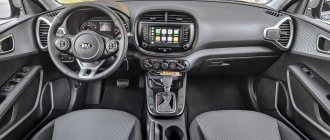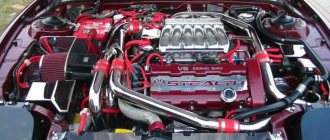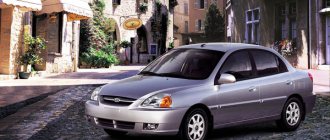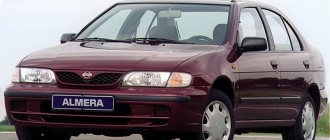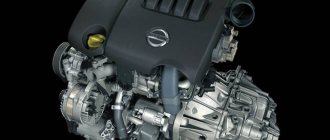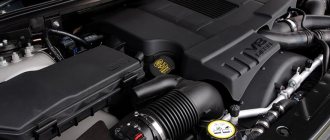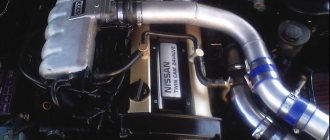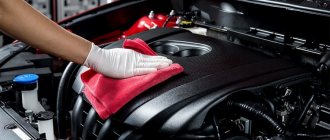Explanation of the name
The encoding of French engines from the manufacturer Renault looks like XnY zzz. In this configuration, the first Latin letter corresponds to the motor series.
- In our case, the letter K means the K series of power units.
- The next value n is a number that indicates the specialization of the engine. For example, the number 4 means a gasoline engine with four valves for each cylinder. In our case, 7 means a gasoline engine with distributed injection and 2 valves per cylinder.
- Next comes the Latin letter, by which you can determine the engine size.
- The following are zzz, an index indicating the features of the power unit installed on a specific car.
- For example, the Renault K7M 710 engines were in production until 2010, they were replaced by the Renault K7M 800 engine. Even numbers 710 and 800 mean that the car has a manual transmission.
Pros and cons of eight-valve K7M from Renault
Today we will “examine” the K7M engine, well known in Russia, which, despite its “venerable” age (in 2020, the “K” series is already a quarter of a century old), is still widely used on models produced under the brands of the international alliance “Renault” -Nissan.”
Despite its rather modest characteristics (in different periods, manufacturers declared a maximum power of 86, 87, 85, 82 or 90 hp), this engine is distinguished by an impressive service life, unpretentiousness to the quality of operating materials, ease of maintenance and high maintainability, which is important in countries , which cannot yet boast of a European level of service.
Brief technical data
K7M is a four-stroke, eight-valve, four-cylinder engine running on gasoline. All its cylinders are located in one row. The engine is located transversely in the front engine compartment.
- Power supply to the power unit - MPi type injector
- The cylinders have a diameter of 79.5 millimeters, the piston stroke length is 80.5 mm.
- The exact engine volume is 1598 cubic centimeters. Combustion chamber compression 9.5
- The rated power at a crankshaft speed of 5500 rpm is 87 hp.
- The maximum torque data at 3000 rpm, crankshaft minute is 128 Nm.
- The fuel used is AI 95, it is acceptable to fill with AI 92.
- The K7M has an electronic ignition system.
- Compliance with environmental standards - Euro 3.
Fuel consumption
Fuel consumption for a volume of 1.6 liters is high: when driving around the city more than 10 liters, on the highway 5.8 liters, total, within 7.3 liters, per 100 km, mileage.
Oil consumption
The permissible consumption of motor lubricant is 0.5 liters per 100 km. You only need to pour K7M oil 5W40, 5W30.
Disadvantages of engines
- Low liter capacity. For example, the 1.6-liter G4FC engine, which is installed in Hyundai and Kia, has a power of 123 hp. and more.
- High fuel consumption. This is facilitated to some extent by the use of manual transmissions with relatively short gears and a 4-speed automatic. Gasoline consumption on Largus (K4M, manual transmission) in the urban cycle reaches 11.7 l/100 km.
- When using AI-92 gasoline in the K4M engine, detonation occurs at certain operating modes. On AI-95 such a problem is not observed.
- The estimated cost of a complete and high-quality overhaul of engines is about 100,000 rubles.
- The price of a new engine is about 300,000-400,000 rubles.
Design features of the Renault K7M BC
The cylinder block, assembled with the cylinder head, clutch and gearbox, form a common mechanism - the power unit. It is mounted on three rubber-metal supports in the engine compartment. The supports located behind and to the left of the BC are attached to the manual transmission housing. The right support has a connection to the timing cover.
The BC of the K9m engine is cast from especially durable cast iron. It does not have BC sleeves. The cylinders are drilled directly into the block. In the lower, inner part of the BC there are five supports intended for the crankshaft main bearings. They have removable covers that are bolted to the BC. The holes for the main bearings are machined, complete with caps installed. Therefore, the latter cannot be swapped. In order not to confuse the covers in places, they are numbered, which starts from the gearbox side. At the ends of the middle support there are sockets for installing thrust half-rings. Which prevent axial displacement of the crankshaft.
The crankshaft plain bearings are made of thin-walled, durable steel with an anti-friction coating. The crankshaft has a design with 5 main and 4 connecting rods. For balancing, counterweights are placed on the crankshaft. Channels are drilled into the shaft to allow oil to flow to the rubbing surfaces of the KV plain bearings.
In front of the crankshaft of the K7M engine there are: a sprocket that drives the oil pump, a pulley with timing teeth and a pulley that drives auxiliary mechanisms. In the pulleys, timing belt and auxiliary mechanisms there are protrusions that fit into the groove located on the toe of the CV. In this way, the pulleys are prevented from turning. The flywheel is bolted to the HF flange. A steel crown is pressed onto it, which is necessary to start the engine with the starter. Also, on the flywheel there is a ring with teeth for a sensor indicating the position of the crankshaft.
The connecting rods have an I-section, made of durable steel. The connecting rods have covers that are attached to them with bolts and nuts.
The pins in the pistons have a tubular cross-section, made of steel. The fingers, tightly pressed into the connecting rods, rotate easily in the piston seats. The piston itself is made of aluminum. The design of the piston is complex. The skirt has an oval and barrel shape. There are three grooves on top of the piston. They are machined for installing rings. There are compression rings on top, and oil scraper rings on the bottom, as usual.
The engine number is not readable: how to remove rust
If the sign is almost rotten, which is not uncommon, do not use harsh mechanical force. Scrapers, blades, sandpaper excluded.
The numbers are engraved very shallowly and you risk destroying the rest. The same applies to the rust converter. The last outlines can simply be washed away along with the corrosion.
For cleaning, WD-40, oil (you can use waste oil), “Silit Plaque and Rust” product, and rags are suitable. And you also need to be patient, which will most likely be rewarded. You can improve the clarity of barely outlined contours using chalk. They need to rub the engraving and then go over it with a rag. The chalk will remain in the tiny indentations and enhance the contrast.
Design features of the cylinder head of the K9M engine
The cylinder head of the K9M engine is made of aluminum. Its design is common to BC. It is secured with ten bolts and centered using two bushings located on the cylinder block body.
A metal, non-shrinking platform is installed between the cylinder head and the BC body. On the top of the cylinder head there are five supports designed to install the camshaft. The design of the supports is one-piece. The camshaft is installed in supports on the front side of the engine. It is driven by a toothed belt from a pulley mounted on the toe of the KV.
On the first journal of the camshaft, on the clutch side of the K7M engine, there is a groove into which the flange rests. It prevents the shaft from moving along the axis.
The thrust flange is fastened with two bolts to the cylinder head housing. An axle intended for installing valve rocker arms is attached to the camshaft supports on top with five screws. The rocker arms on the axle are kept from moving by two brackets. The brackets are secured using the rocker arm axle bolts. Screws are screwed into the rocker arms to adjust valve clearances. The screws have lock nuts to secure the screws in the desired position.
Guide bushings and valve seats K7m are pressed into the cylinder head. The valve bushings are equipped with oil reflective caps. Steel valves are located in two rows. Ahead of the machine there is a series of valves designed to release exhaust gases. And at the back there is a row of valves designed to admit the fuel mixture. The valve is opened by a rocker arm, and closed by the action of a spring.
So what's the end result?
I will end, however, on a positive note.
Yes, the K7M design is pretty dated; yes, there are a number of engineering shortcomings and characteristic “sores”; Yes, the indicators are by no means phenomenal; however, we should not forget that this engine was originally intended for a group of “budget” models, many of which are “workhorses” - taxis, vans, MPVs.
And if it weren’t for what it is, then probably many would not be able to afford a car equipped with a different, more efficient, but also more expensive engine that requires much more attention during its operation and maintenance.
Therefore, we can confidently say: the K7M engine is fully suitable for the tasks for which it was created.
Useful information? - like it. If you know what to add or intend to refute, write in the comments. The material was prepared by Nikolay Orekhov.
Lubrication of the K7M power unit
K7M motor lubrication is combined. The crankshaft connecting rod and main bearings, as well as the camshaft bearings, are lubricated under pressure. The remaining parts of the motor receive lubrication from splashing. A gear oil pump located in the front of the oil pan creates pressure. Thanks to which, through the channels, engine oil flows to the rubbing parts. The oil pump is chain driven from the crankshaft.
The drive sprocket, which drives the pump, is installed on the crankshaft, under the cylinder block cover located in front. The sprocket has a belt for the operation of the front crankshaft oil seal. The drive sprocket is clamped between the crankshaft shoulder and the timing pulley and tightened with a bolt that secures the accessory pulley drive.
The oil receiver of the K7M engine has a common design with the MN housing cover. The cover, in turn, is attached with five bolts to the MN body. The pressure reducing valve is held by a spring retainer from falling out of the MH housing cover.
Motor lubricant flows from the oil pan through the oil intake filter into the oil pump. Then, under pressure, from the oil pump, through the oil filter, motor lubricant enters the lubrication channel. The channel is made in the BC and is intended to supply oil to the crankshaft sliding bearings. Motor lubricant is supplied to the cylinder head via a vertical line in the cylinder head to lubricate all rubbing parts.
Unpretentious and reliable Renault engine - K7M
In the mid-90s, the K7M was born - the engine that marked the beginning of the K-series family. Subsequently, K4J, K4M, K9K and K4M motors appeared in this line.
The K7M in-line internal combustion engine had eight valves and a volume of 1.6 liters. It has become the main one for the budget segment of the Dacia and Renault models. The assembly was first launched in 1995 in Spain (the city of Valladolid). After 9 years (2004), production was moved to Romania.
Possible problems of K7M and ways to eliminate them
The K7M power unit has a reliable design, but it also has weaknesses:
Overheat
Overheating on the K7M power unit is not uncommon. The result of overheating is burnout of the cylinder head gasket. Overheating is most often caused by a faulty thermostat. Therefore, before replacing the cylinder head gasket, you first need to eliminate the cause of overheating.
Engine tripping
This engine can trip. Often, the cause is a cracked ignition coil insulator. But before changing it, you should check the condition of the high-voltage wires and spark plugs.
The car jerks at low speed
The revolutions are floating
Floating idle speed indicates a failure of the idle speed regulator. But the fuel filter may be clogged or the fuel pump may not be working properly.
crank mechanism
The most serious problem on the K7M engine is too rapid wear of the crankshaft. This will be indicated by metallic knocking and ringing in the power unit. The problem can be solved by replacing the crankshaft plain bearings.
Engine mount wear
Minor problems often occur, such as wear of engine mounts, and failure of various sensors. Replacing these parts does not require much intelligence, and their price is not high.
Common engine problems
- The K7M engine often has a leaking front crankshaft oil seal. During the repair, you will have to remove the timing belt and carry out a number of other complex works.
- Problems with the ignition coil (insulators dry out and crack), injectors or spark plugs. Because of this, the engine starts to stall.
- Frequent malfunction of the crankshaft position sensor.
- An insufficiently reliable thermostat, as well as an oil leak from the heat exchanger of the thermostat housing (oil can get into the antifreeze or ooze out).
- The timing belt begins to slip off the pulleys when there is play in the pump bearing, a bent roller stud, or wear on the roller bearing. When replacing a belt, it is recommended to immediately replace all these elements, which will cost a considerable amount (about 9,000 rubles).
Experts note that the K4M/K7M engine family is obsolete, but the modest characteristics are compensated by the relatively high reliability and maintainability of the engines. What reviews can you leave about these motors?
Service Features
Change of oil
Like all engines, changing the engine oil is an important event on the K7M engine. It must be carried out simultaneously with replacing the oil filter, after 15 thousand km. In order not to make premature repairs to the crankshaft, it is better to reduce this period by half.
The spark plugs and air filter must be replaced after 30,000 kilometers.
Replacing the timing belt
The alternator and timing belts need to be changed after 60 thousand km; it is better not to tighten the timing belt when replacing it. Since when it ruptures, the pistons will collide with the valves.
The fuel pump and pump should be replaced after 120 thousand kilometers.
Design miscalculations of engines
- Outdated cylinder head design without phase shifters and adjustable intake tract lengths. As a result, high fuel consumption.
- When the timing belt breaks, the valves meet the pistons.
- The K7M engine (8 cells) does not have hydraulic compensators. As a result, the valves need to be adjusted (however, using high-quality motor oil, adjustment may be required closer to 100,000 km).
- The engine is noisy and vibration-laden.
- Rapid contamination of the idle air regulator. As a result, the idle speed begins to fluctuate.
- Poor oil separator design: the channels are cast directly into the valve cover. In this case, many labyrinth channels are sealed only with sealant. Over time, this causes engine oil to leak, and eliminating such leaks requires a lot of attention and scrupulousness.
- The oil filter is inconveniently located on the K4M engine and the generator is in the way.
